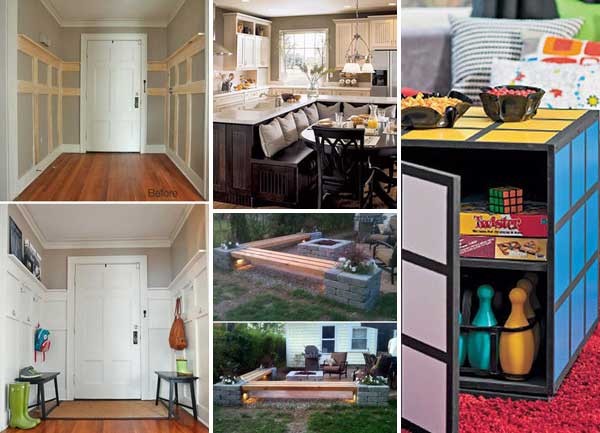
A home equity mortgage may be a good choice if you're thinking about a remodel. This loan can pay for your project and is a smart option to finance it. The interest paid on a home equity mortgage can be deducted from your tax. Rates for home equity loans can vary greatly so make sure to shop around to find the best deal. Although the terms and rates can be very different, choosing the right lender will save you money over the long-term.
If you have a good credit score, you can choose a fixed-rate home equity loan. This type gives you the security of knowing how much you'll pay each month. Variable rate HELOCs may be more appropriate if you plan on remodeling in stages. This loan can be taken out in smaller amounts, and is flexible. You should also consider the interest rate when you are considering a home-equity loan for remodel.
A home equity loan might be the best choice for you if you are planning major renovations. You won't have to spend all the money you borrow, but you will save money on labor and materials. Another option is to apply for a home equity line of credit. You can get the funds you need with a home equity credit without having to apply for a traditional loan. Although this loan offers more flexibility, you will still have to pay interest on the amount you use during the draw period.

Home equity loans and home equity lines are the best options for financing a home remodel. HELOCs work in the same way as credit cards but you can borrow up 80 percent of your home's actual value instead of applying to for a loan. The HELOC will be available for up to five years and require monthly payments and a fixed rate of interest. You must show proof of income and the reason you are applying for a line credit. You should be able to get a home equity loan to finance the project.
Home equity loans are a debt that will eventually have a repayment. You should also remember that a home equity loans can be used to renovate your home and increase its value. As a homeowner, you may want to consider a home equity loan to finance your project, but make sure to read the terms carefully. You can speak to a financial adviser if you have any questions.
FAQ
How important do you need to be preapproved for a mortgage loan?
Pre-approval is crucial for getting a mortgage. It gives you an idea how much money it will cost. It helps you to determine if your loan application is eligible.
Do I need an architect/builder?
If you are planning to renovate your own home, it may be easier to just hire someone else to do the work for you. If you're looking to purchase a home, an architect or builder can help you achieve your goals.
How should house renovations be ordered?
It is important to determine where you want to place everything when renovating your house. If you're planning on selling your home soon, it is important to consider how you wish to present your home for potential buyers. The design of your kitchen and living room should be considered. After you have selected the rooms you wish to renovate you can begin searching for contractors who specialize. Once you have hired a contractor you can begin work on your renovation project.
Statistics
- ‘The potential added value of a loft conversion, which could create an extra bedroom and ensuite, could be as much as 20 per cent and 15 per cent for a garage conversion.' (realhomes.com)
- Design-builders may ask for a down payment of up to 25% or 33% of the job cost, says the NARI. (kiplinger.com)
- On jumbo loans of more than $636,150, you'll be able to borrow up to 80% of the home's completed value. (kiplinger.com)
- The average fixed rate for a home-equity loan was recently 5.27%, and the average variable rate for a HELOC was 5.49%, according to Bankrate.com. (kiplinger.com)
- Most lenders will lend you up to 75% or 80% of the appraised value of your home, but some will go higher. (kiplinger.com)
External Links
How To
How do I plan a whole house remodel?
Planning a whole house remodel requires careful planning and research. Before you even start your project there are many important things that you need to take into consideration. It is important to determine what type of home improvements you are looking to make. You can choose from a variety of categories, such as kitchen or bathroom, bedroom, living space, or living room. Once you've decided on which category to work on you will need to calculate how much money is available for your project. It's best to budget at least $5,000 per room if you don't have any experience working on homes. If you have some previous experience, you may be capable of getting away with a lower amount.
Once you know how much money your budget allows you to spend, then you will need to decide how big a job it is you are willing to take on. If you have only enough money to remodel a small kitchen, you may not be able add new flooring, countertops, or paint the walls. You can do almost everything if you have enough cash for a full-scale kitchen renovation.
Next, find a contractor who is skilled in the type and scope of work you wish to undertake. This will ensure you get quality results and save you a lot of hassle later. Once you have found a reliable contractor, it is time to start gathering supplies and materials. You may need to purchase everything from scratch depending on the size and scope of your project. However, you won't have to worry about finding the exact item you are looking for in the many pre-made shops.
Once you've gathered the supplies needed, it's now time to start planning. Begin by sketching out a rough plan of where furniture and appliances will be placed. Next, design the layout of your rooms. It is important to allow for electrical and plumbing outlets. It is a good idea to place the most important areas nearest the front door. This will make it easier for visitors to access them. Final touches to your design include choosing the right colors and finishes. You can save money by using neutral colors and simple designs.
Now that your plan is complete, it's time you start building! Before you start building, check your local codes. Some cities require permits while others allow homeowners to build without one. When you're ready to begin construction, you'll first want to remove all existing floors and walls. To protect your flooring, you will lay plywood sheets. Then, you'll nail or screw together pieces of wood to form the frame for your cabinets. Lastly, you'll attach doors and windows to the frame.
There are some final touches that you will need to make after you are done. You will likely need to cover exposed wires and pipes. Plastic sheeting and tape are used to cover exposed wires. You will also need to hang photos and mirrors. Just remember to keep your work area clean and tidy at all times.
These steps will help you create a functional, beautiful home that is both functional and attractive. Now that you know how to plan a whole house remodeling project, you can go ahead and get started!